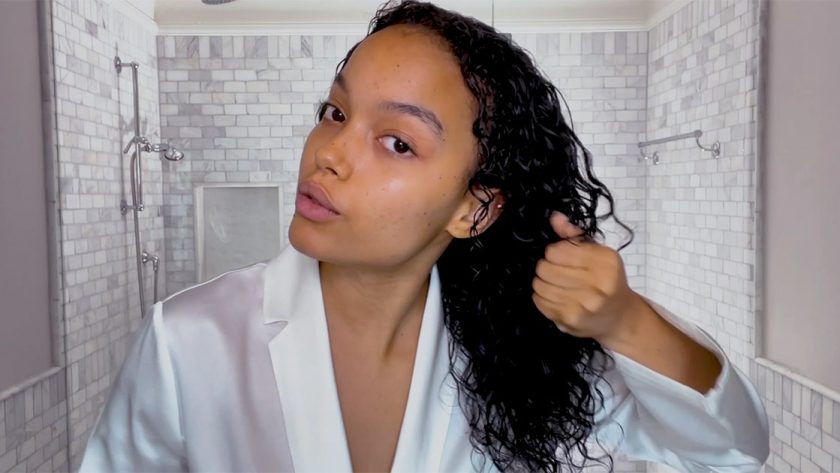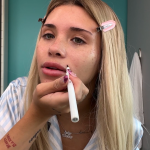Let’s start by identifying the damage. Here, we break down three common causes of damaged hair, how to mitigate the harm, and reparative steps to take to make your lengths as healthy as possible.
1. Mechanical Damage
How Does Mechanical Damage Occur?
Mechanical damage is caused by hair wear-and-tear. Dragging combs and brushes through your lengths, tying styles with taut ties and ribbons, and even exposing hair to the elements all take their toll over time. All of these externals can lead to the breakage of individual strands, weathering (and even eradicating) protective cuticles and any potential for lustrousness and leading instead to a frazzled and frizzy mane.
How to Repair Damaged Hair
While certain products exist to address damage caused by chemicals (read on for more) our experts insist that you cannot restore split ends or breakage in severely damaged hair. The solution here is a trim or perhaps a full-on chop, the better to part ways with split ends before the breakage travels upward.
To minimize the signs of mechanical damage, take a break from even the most basic of tools and embrace your natural texture with the help of products like Vernon François Nourishing Water or Ceremonia’s Guava Beach Waves. Additionally, oils like JVN Complete Nourishing Hair Oil Shine Drops and No Frizz Vanishing Oil from Living Proof can quell frizz and ramp up radiance as your hair starts to heal.
How to Prevent Further Damage
“Wet hair is very fragile; handle with care,” says celebrity hairstylist Bridget Brager, who urges the use of a wide-tooth comb or wet brush. Her advice is to work from the ends of the hair up and let the hair air dry as much as possible before styling. This same kind of hair is necessary when you’re blowdrying. “Choose a boar bristle brush or one that has a mix of plastic and boar’s hair bristles,” says Hill. “The idea is to stay away from metal brushes, which can abrasive to hair fiber and scalps.” Try Christophe Robin Special Blow Dry Hair Brush or Crown Affair’s The Brush No. 001 for safer styling.
Another way to extend your style? Protect it while you sleep with satin or silk pillowcases, scarves, and bonnets. “Create a signature sleep style that allows oxygen to flow through the hair to the scalp, to prevent tangling and matting in the occipital point of the head while you sleep,” explains Hill, citing twists, pin curls, large braids, or the pineapple method as excellent sleep styles.
2. Chemical Damage
How Does Chemical Damage Occur?
Fans of hair color and retexturizing treatments, take note: chemical damage is an insidious sort. While occasional chemical processing—accompanied by a strategic and regimented hair care routine—is no cause for concern, treatments that are too frequent, too harsh, or not accompanied by proper tending can lead to progressive deterioration of hair cuticles. Without intact cuticles, strands lose their ability to retain moisture, leading to loss of gloss, elasticity, and ultimately, breakage. TLDR: Bleaching may make hair appear plump, and retexturing may make daily styling easier, but chemicals do significant damage to protein structures over time.
How to Repair Damaged Hair
Bond-building hair products have been all the rage in recent years, and for good reason. “You can improve the quality of hair after slight chemical damage using bond-building products that will rebuild the amino acid bonds that make up the keratin in hair, however, you cannot restore split ends or breakage in severely damaged hair,” details Caspara. Options like Olaplex No. 7 Bonding Oil or K18 Biomimetic Hairscience Leave-In Molecular Repair Hair Mask are two of the market’s most talked about formulas, but Living Proof Triple Bond Complex and Bumble and bumble Bond-Building Repair Treatment both promise to strengthen hair and resist future damage, too.
How to Prevent Further Damage
Though bond-building products help hair, regular maintenance is ultimate step toward prevention. “The only way to rectify severe thermal or chemical damage is to frequently trim off dead ends and allow for healthier hair to grow down without being affected by lingering damage,” says Caspara. Brager agrees that regular trims can reduce split ends from fraying and breaking off, allowing you (and your hair!) to avoid more dramatic damage.
3. Heat Damage
How Does Heat Damage Occur?
Though heat tools may help our hair appear perfect, relying on them too frequently can do lasting harm to lengths. As with chemical processing, the repeated application of heat erodes the cuticle and weathers strands, leading to breakage over time. Too-high heat can even cause immediate damage, literally singing the very strands you’re trying to style.
How to Repair Damaged Hair
While there’s no way to undo heat damage entirely, regular trims and an overhaul of your daily products can help. Take stock of your shampoo and conditioner to ensure both are free of harsh sulfates.



